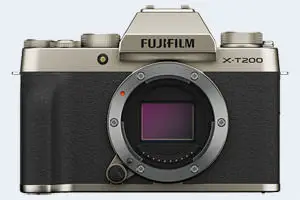Fujifilm X-T200 vs Kodak AZ901
The Fujifilm X-T200 and the Kodak PixPro AZ901 are two digital cameras that were revealed to the public, respectively, in January 2020 and January 2016. The X-T200 is a mirrorless interchangeable lens camera, while the AZ901 is a fixed lens compact. The cameras are based on an APS-C (X-T200) and a 1/2.3-inch (AZ901) sensor. The Fujifilm has a resolution of 24 megapixels, whereas the Kodak provides 20.2 MP.
Below is an overview of the main specs of the two cameras as a starting point for the comparison.

Check X-T200 offers at
ebay.com

Check AZ901 price at
amazon.com
Going beyond this snapshot of core features and characteristics, what are the differences between the Fujifilm X-T200 and the Kodak PixPro AZ901? Which one should you buy? Read on to find out how these two cameras compare with respect to their body size, their imaging sensors, their shooting features, their input-output connections, and their reception by expert reviewers.
Body comparison
The side-by-side display below illustrates the physical size and weight of the Fujifilm X-T200 and the Kodak AZ901. The two cameras are presented according to their relative size. Three consecutive perspectives from the front, the top, and the back are available. All width, height and depth dimensions are rounded to the nearest millimeter.
The X-T200 can be obtained in three different colors (silver, gold, titanium), while the AZ901 is only available in black.
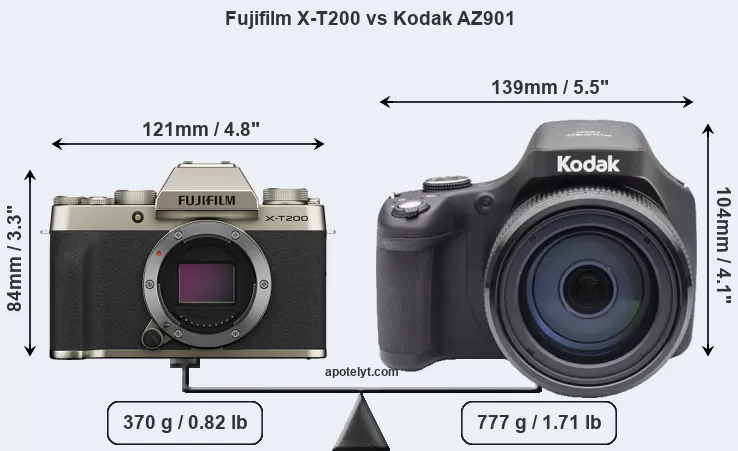
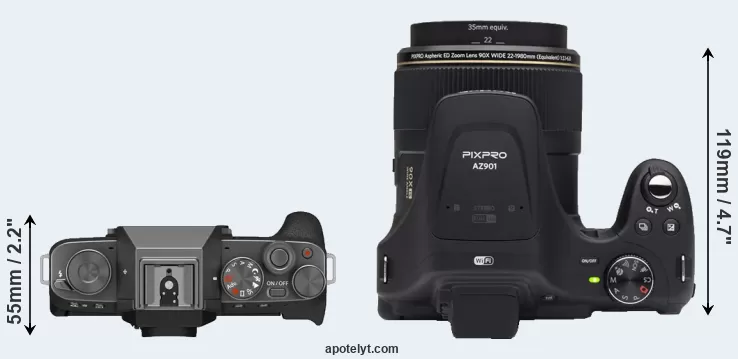
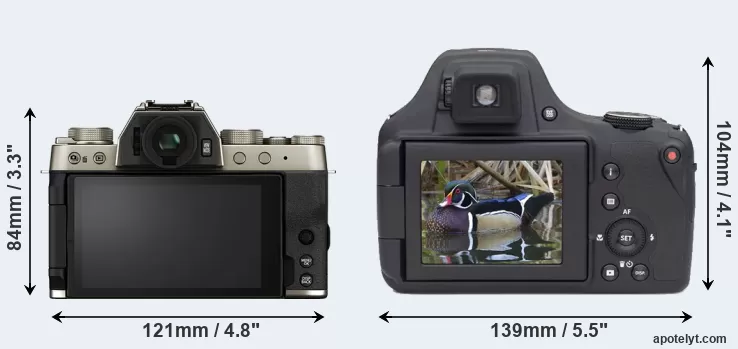
If the front view area (width x height) of the cameras is taken as an aggregate measure of their size, the Kodak AZ901 is notably larger (42 percent) than the Fujifilm X-T200. In this context, it is worth noting that neither the X-T200 nor the AZ901 are weather-sealed.
The above size and weight comparisons are to some extent incomplete and possibly misleading, as the AZ901 has a lens built in, whereas the X-T200 is an interchangeable lens camera that requires a separate lens. Attaching the latter will add extra weight and bulk to the setup. You can compare the optics available for the X-T200 and their specifications in the Fujinon X Lens Catalog.
Concerning battery life, the X-T200 gets 270 shots out of its Fujifilm NP-W126S battery, while the AZ901 can take 400 images on a single charge of its Kodak LB-070 power pack. The power pack in the X-T200 can be charged via the USB port, so that it is not always necessary to take the battery charger along when travelling.
The adjacent table lists the principal physical characteristics of the two cameras alongside a wider set of alternatives. If you want to switch the focus of the display and review another camera pair, you can move across to the CAM-parator tool and choose from the broad selection of possible camera comparisons there.

| Camera Model |
Camera Width |
Camera Height |
Camera Depth |
Camera Weight |
Battery Life |
Weather Sealing |
Camera Launch |
Launch Price (USD) |
Street Price |
||
|---|---|---|---|---|---|---|---|---|---|---|---|
| 1. | Fujifilm X-T200 | 121 mm | 84 mm | 55 mm | 370 g | 270 | n | Jan 2020 | 699 | ebay.com | |
| 2. | Kodak AZ901 | 139 mm | 104 mm | 119 mm | 777 g | 400 | n | Jan 2016 | 499 | amazon.com | |
| 3. | Canon G9 X | 98 mm | 58 mm | 31 mm | 209 g | 220 | n | Oct 2015 | 529 | ebay.com | |
| 4. | Fujifilm X-A3 | 117 mm | 67 mm | 40 mm | 339 g | 410 | n | Aug 2016 | 399 | ebay.com | |
| 5. | Fujifilm X-A7 | 119 mm | 68 mm | 41 mm | 320 g | 440 | n | Sep 2019 | 499 | ebay.com | |
| 6. | Fujifilm X-E2S | 129 mm | 75 mm | 37 mm | 350 g | 350 | n | Jan 2016 | 699 | ebay.com | |
| 7. | Fujifilm X-E3 | 121 mm | 74 mm | 43 mm | 337 g | 350 | n | Sep 2017 | 899 | ebay.com | |
| 8. | Fujifilm X-E4 | 121 mm | 73 mm | 33 mm | 364 g | 380 | n | Jan 2021 | 849 | amazon.com | |
| 9. | Fujifilm X-T10 | 118 mm | 83 mm | 41 mm | 381 g | 350 | n | May 2015 | 799 | ebay.com | |
| 10. | Fujifilm X-T20 | 118 mm | 83 mm | 41 mm | 383 g | 350 | n | Jan 2017 | 899 | ebay.com | |
| 11. | Fujifilm X-T30 | 118 mm | 83 mm | 47 mm | 383 g | 380 | n | Feb 2019 | 899 | ebay.com | |
| 12. | Fujifilm X-T30 II | 118 mm | 83 mm | 47 mm | 383 g | 380 | n | Sep 2021 | 899 | amazon.com | |
| 13. | Fujifilm X-T100 | 121 mm | 83 mm | 47 mm | 448 g | 430 | n | May 2018 | 599 | ebay.com | |
| 14. | Leica Q Typ 116 | 130 mm | 80 mm | 93 mm | 640 g | 300 | n | Jun 2015 | 4,249 | ebay.com | |
| 15. | Nikon B700 | 125 mm | 85 mm | 107 mm | 565 g | 350 | n | Feb 2016 | 499 | ebay.com | |
| 16. | Sony HX90V | 102 mm | 58 mm | 36 mm | 245 g | 360 | n | Apr 2015 | 429 | ebay.com | |
| 17. | Sony HX350 | 130 mm | 93 mm | 103 mm | 652 g | 300 | n | Dec 2016 | 449 | ebay.com | |
| Note: Measurements and pricing do not include easily detachable parts, such as add-on or interchangeable lenses or optional viewfinders. | |||||||||||
Any camera decision will obviously take relative prices into account. The retail prices at the time of the camera’s release place the model in the market relative to other models in the producer’s line-up and the competition. The AZ901 was launched at a lower price than the X-T200, despite having a lens built in. Usually, retail prices stay at first close to the launch price, but after several months, discounts become available. Later in the product cycle and, in particular, when the replacement model is about to appear, further discounting and stock clearance sales often push the camera price considerably down. Then, after the new model is out, very good deals can frequently be found on the pre-owned market.
Sensor comparison
The size of the sensor inside a digital camera is one of the key determinants of image quality. All other things equal, a large sensor will have larger individual pixel-units that offer better low-light sensitivity, wider dynamic range, and richer color-depth than smaller pixels in a sensor of the same technological generation. Further, a large sensor camera will give the photographer additional creative options when using shallow depth-of-field to isolate a subject from its background. On the downside, larger sensors tend to be more expensive and lead to bigger and heavier cameras and lenses.
Of the two cameras under consideration, the Fujifilm X-T200 features an APS-C sensor and the Kodak AZ901 a 1/2.3-inch sensor. The sensor area in the AZ901 is 92 percent smaller. As a result of these sensor size differences, the cameras have a format factor of, respectively, 1.5 and 5.6. The sensor in the X-T200 has a native 3:2 aspect ratio, while the one in the AZ901 offers a 4:3 aspect.
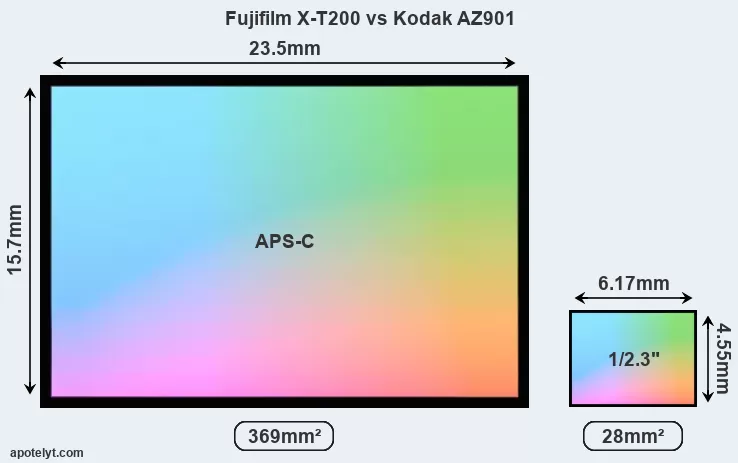
With 24MP, the X-T200 offers a higher resolution than the AZ901 (20.2MP), but the X-T200 nevertheless has larger individual pixels (pixel pitch of 3.92μm versus 1.18μm for the AZ901) due to its larger sensor. Moreover, the X-T200 is a much more recent model (by 4 years) than the AZ901, and its sensor will have benefitted from technological advances during this time that further enhance the light gathering capacity of its pixels.
The resolution advantage of the Fujifilm X-T200 implies greater flexibility for cropping images or the possibility to print larger pictures. The maximum print size of the X-T200 for good quality output (200 dots per inch) amounts to 30 x 20 inches or 76.2 x 50.8 cm, for very good quality (250 dpi) 24 x 16 inches or 61 x 40.6 cm, and for excellent quality (300 dpi) 20 x 13.3 inches or 50.8 x 33.9 cm. The corresponding values for the Kodak AZ901 are 25.9 x 19.4 inches or 65.8 x 49.4 cm for good quality, 20.7 x 15.6 inches or 52.7 x 39.5 cm for very good quality, and 17.3 x 13 inches or 43.9 x 32.9 cm for excellent quality prints.
The X-T200 has on-sensor phase detect pixels, which results in fast and reliable autofocus acquisition even during live view operation.
The Fujifilm X-T200 has a native sensitivity range from ISO 200 to ISO 12800, which can be extended to ISO 100-51200. The corresponding ISO settings for the Kodak PixPro AZ901 are ISO 100 to ISO 3200 (no boost).
In terms of underlying technology, the X-T200 is build around a CMOS sensor, while the AZ901 uses a BSI-CMOS imager. Both cameras use a Bayer filter for capturing RGB colors on a square grid of photosensors. This arrangement is found in most digital cameras.
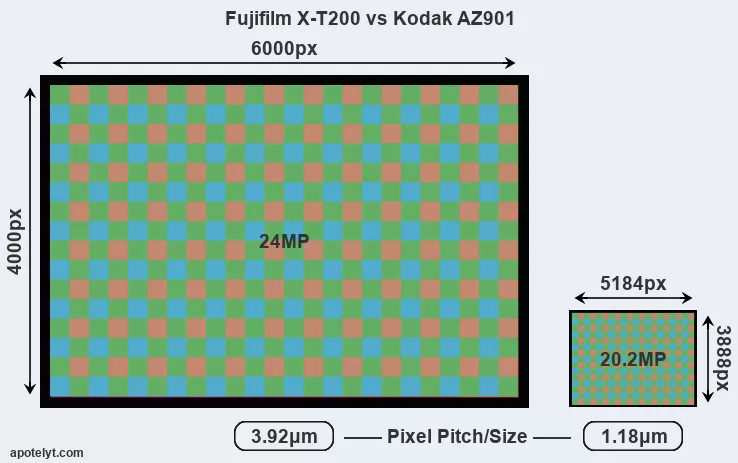
For many cameras, data on sensor performance has been reported by DXO Mark. This service assesses and scores the color depth ("DXO Portrait"), dynamic range ("DXO Landscape"), and low-light sensitivity ("DXO Sports") of camera sensors, and also publishes an overall camera score. The following table provides an overview of the physical sensor characteristics, as well as the sensor quality measurements for a selection of comparators.

| Camera Model |
Sensor Class |
Resolution (MP) |
Horiz. Pixels |
Vert. Pixels |
Video Format |
DXO Portrait |
DXO Landscape |
DXO Sports |
DXO Overall |
||
|---|---|---|---|---|---|---|---|---|---|---|---|
| 1. | Fujifilm X-T200 | APS-C | 24.0 | 6000 | 4000 | 4K/30p | 24.1 | 13.6 | 1991 | 84 | |
| 2. | Kodak AZ901 | 1/2.3 | 20.2 | 5184 | 3888 | 1080/30p | 20.3 | 11.7 | 806 | 48 | |
| 3. | Canon G9 X | 1-inch | 20.0 | 5472 | 3648 | 1080/60p | 21.5 | 12.3 | 495 | 63 | |
| 4. | Fujifilm X-A3 | APS-C | 24.0 | 6000 | 4000 | 1080/60p | 23.8 | 13.1 | 1664 | 81 | |
| 5. | Fujifilm X-A7 | APS-C | 24.0 | 6000 | 4000 | 4K/30p | 24.1 | 13.6 | 1955 | 84 | |
| 6. | Fujifilm X-E2S | APS-C | 16.0 | 4896 | 3264 | 1080/60p | 23.7 | 13.0 | 1608 | 80 | |
| 7. | Fujifilm X-E3 | APS-C | 24.0 | 6000 | 4000 | 4K/30p | 23.9 | 13.3 | 1764 | 82 | |
| 8. | Fujifilm X-E4 | APS-C | 26.0 | 6240 | 4160 | 4K/30p | 24.2 | 13.7 | 2085 | 85 | |
| 9. | Fujifilm X-T10 | APS-C | 16.0 | 4896 | 3264 | 1080/60p | 23.7 | 12.9 | 1546 | 79 | |
| 10. | Fujifilm X-T20 | APS-C | 24.0 | 6000 | 4000 | 4K/30p | 23.9 | 13.2 | 1704 | 81 | |
| 11. | Fujifilm X-T30 | APS-C | 26.0 | 6240 | 4160 | 4K/30p | 24.1 | 13.5 | 1895 | 83 | |
| 12. | Fujifilm X-T30 II | APS-C | 26.0 | 6240 | 4160 | 4K/30p | 24.2 | 13.8 | 2144 | 85 | |
| 13. | Fujifilm X-T100 | APS-C | 24.0 | 6000 | 4000 | 4K/15p | 24.0 | 13.4 | 1829 | 83 | |
| 14. | Leica Q Typ 116 | Full Frame | 24.0 | 6000 | 4000 | 1080/60p | 24.3 | 12.7 | 2221 | 85 | |
| 15. | Nikon B700 | 1/2.3 | 20.2 | 5184 | 3888 | 4K/30p | 20.4 | 11.8 | 818 | 48 | |
| 16. | Sony HX90V | 1/2.3 | 18.0 | 4896 | 3672 | 1080/60p | 20.2 | 11.6 | 738 | 47 | |
| 17. | Sony HX350 | 1/2.3 | 19.9 | 5152 | 3864 | 1080/60p | 20.5 | 11.9 | 896 | 49 | |
| Note: DXO values in italics represent estimates based on sensor size and age. | |||||||||||
Many modern cameras cannot only take still pictures, but also record videos. The two cameras under consideration both have sensors whose read-out speed is fast enough to capture moving pictures, but the X-T200 provides a higher video resolution than the AZ901. It can shoot video footage at 4K/30p, while the Kodak is limited to 1080/30p.
Feature comparison
Apart from body and sensor, cameras can and do differ across a variety of features. The two cameras under consideration are similar with respect to both having an electronic viewfinder. However, the one in the X-T200 offers a substantially higher resolution than the one in the AZ901 (2360k vs 202k dots). The adjacent table lists some of the other core features of the Fujifilm X-T200 and Kodak AZ901 along with similar information for a selection of comparators.

| Camera Model |
Viewfinder (Type or 000 dots) |
Control Panel (yes/no) |
LCD Specifications (inch/000 dots) |
LCD Attach- ment |
Touch Screen (yes/no) |
Max Shutter Speed * |
Max Shutter Flaps * |
Built-in Flash (yes/no) |
Built-in Image Stab |
||
|---|---|---|---|---|---|---|---|---|---|---|---|
| 1. | Fujifilm X-T200 | 2360 | n | 3.5 / 2780 | swivel | Y | 1/4000s | 8.0/s | Y | n | |
| 2. | Kodak AZ901 | 202 | n | 3.0 / 920 | swivel | n | 1/2000s | 5.0/s | Y | Y | |
| 3. | Canon G9 X | none | n | 3.0 / 1040 | fixed | Y | 1/2000s | 6.0/s | Y | Y | |
| 4. | Fujifilm X-A3 | none | n | 3.0 / 1040 | tilting | Y | 1/4000s | 6.0/s | Y | n | |
| 5. | Fujifilm X-A7 | none | n | 3.5 / 2760 | swivel | Y | 1/4000s | 6.0/s | Y | n | |
| 6. | Fujifilm X-E2S | 2360 | n | 3.0 / 1040 | fixed | n | 1/4000s | 7.0/s | Y | n | |
| 7. | Fujifilm X-E3 | 2360 | n | 3.0 / 1040 | fixed | Y | 1/4000s | 8.0/s | n | n | |
| 8. | Fujifilm X-E4 | 2360 | n | 3.0 / 1620 | tilting | Y | 1/4000s | 8.0/s | n | n | |
| 9. | Fujifilm X-T10 | 2360 | n | 3.0 / 920 | tilting | n | 1/4000s | 8.0/s | Y | n | |
| 10. | Fujifilm X-T20 | 2360 | n | 3.0 / 1040 | tilting | Y | 1/4000s | 8.0/s | Y | n | |
| 11. | Fujifilm X-T30 | 2360 | n | 3.0 / 1040 | tilting | Y | 1/4000s | 8.0/s | Y | n | |
| 12. | Fujifilm X-T30 II | 2360 | n | 3.0 / 1620 | tilting | Y | 1/4000s | 8.0/s | Y | n | |
| 13. | Fujifilm X-T100 | 2360 | n | 3.0 / 1040 | swivel | Y | 1/4000s | 6.0/s | Y | n | |
| 14. | Leica Q Typ 116 | 3680 | n | 3.0 / 1040 | fixed | Y | 1/2000s | 10.0/s | n | Y | |
| 15. | Nikon B700 | 921 | n | 3.0 / 921 | swivel | n | 1/4000s | 5.0/s | Y | Y | |
| 16. | Sony HX90V | 638 | n | 3.0 / 921 | tilting | n | 1/2000s | 10.0/s | Y | Y | |
| 17. | Sony HX350 | 202 | n | 3.0 / 922 | tilting | n | 1/4000s | 10.0/s | Y | Y | |
| Note: *) Information refers to the mechanical shutter, unless the camera only has an electronic one. | |||||||||||
One differentiating feature between the two cameras concerns the touch sensitivity of the rear screen. The X-T200 has a touchscreen, while the AZ901 has a conventional panel. Touch control can be particularly helpful, for example, for setting the focus point.
Both cameras have an articulated rear screen that can be turned to be front-facing. This feature will be particularly appreciated by vloggers and photographers who are interested in taking selfies.The reported shutter speed information refers to the use of the mechanical shutter. Yet, some cameras only have an electronic shutter, while others have an electronic shutter in addition to a mechanical one. In fact, the X-T200 is one of those camera that have an additional electronic shutter, which makes completely silent shooting possible. However, this mode is less suitable for photographing moving objects (risk of rolling shutter) or shooting under artificial light sources (risk of flickering).
The Fujifilm X-T200 has an intervalometer built-in. This enables the photographer to capture time lapse sequences, such as flower blooming, a sunset or moon rise, without purchasing an external camera trigger and related software.
Concerning the storage of imaging data, both the X-T200 and the AZ901 write their files to SDXC cards. The X-T200 supports UHS-I cards (Ultra High Speed data transfer of up to 104 MB/s), while the AZ901 cannot take advantage of Ultra High Speed SD cards.
Connectivity comparison
For some imaging applications, the extent to which a camera can communicate with its environment can be an important aspect in the camera decision process. The table below provides an overview of the connectivity of the Fujifilm X-T200 and Kodak PixPro AZ901 and, in particular, the interfaces the cameras (and selected comparators) provide for accessory control and data transfer.

| Camera Model |
Hotshoe Port |
Internal Mic / Speaker |
Microphone Port |
Headphone Port |
HDMI Port |
USB Port |
WiFi Support |
NFC Support |
Bluetooth Support |
||
|---|---|---|---|---|---|---|---|---|---|---|---|
| 1. | Fujifilm X-T200 | Y | stereo / mono | Y | Y | micro | 3.1 | Y | - | Y | |
| 2. | Kodak AZ901 | - | stereo / mono | - | - | micro | 2.0 | Y | - | - | |
| 3. | Canon G9 X | - | stereo / mono | - | - | micro | 2.0 | Y | Y | - | |
| 4. | Fujifilm X-A3 | Y | stereo / mono | - | - | micro | 2.0 | Y | - | - | |
| 5. | Fujifilm X-A7 | Y | stereo / mono | Y | - | micro | 2.0 | Y | - | Y | |
| 6. | Fujifilm X-E2S | Y | stereo / mono | Y | - | micro | 2.0 | Y | - | - | |
| 7. | Fujifilm X-E3 | Y | stereo / mono | Y | - | micro | 2.0 | Y | - | Y | |
| 8. | Fujifilm X-E4 | Y | stereo / mono | Y | - | micro | 3.2 | Y | - | Y | |
| 9. | Fujifilm X-T10 | Y | stereo / mono | Y | - | micro | 2.0 | Y | - | - | |
| 10. | Fujifilm X-T20 | Y | stereo / mono | Y | - | micro | 2.0 | Y | - | - | |
| 11. | Fujifilm X-T30 | Y | stereo / mono | Y | - | micro | 3.1 | Y | - | Y | |
| 12. | Fujifilm X-T30 II | Y | stereo / mono | Y | - | micro | 3.2 | Y | - | Y | |
| 13. | Fujifilm X-T100 | Y | stereo / mono | Y | - | micro | 2.0 | Y | - | Y | |
| 14. | Leica Q Typ 116 | Y | stereo / mono | - | - | micro | 2.0 | Y | Y | - | |
| 15. | Nikon B700 | - | stereo / mono | - | - | micro | 2.0 | Y | Y | Y | |
| 16. | Sony HX90V | - | stereo / mono | - | - | micro | 2.0 | Y | Y | - | |
| 17. | Sony HX350 | - | stereo / mono | - | - | micro | 2.0 | - | - | - |
It is notable that the X-T200 has a hotshoe, while the AZ901 does not. This socket makes it possible to easily attach optional accessories, such as an external flash gun.
The AZ901 is a recent model that features in the current product line-up of Kodak. In contrast, the X-T200 has been discontinued (but can be found pre-owned on ebay). There has not been a direct replacement model for the X-T200 from Fujifilm. Further information on the features and operation of the X-T200 and AZ901 can be found, respectively, in the Fujifilm X-T200 Manual (free pdf) or the online Kodak AZ901 Manual.
Review summary
So what conclusions can be drawn? Is there a clear favorite between the Fujifilm X-T200 and the Kodak AZ901? Which camera is better? The listing below highlights the relative strengths of the two models.

Advantages of the Fujifilm X-T200:
- More detail: Offers more megapixels (24 vs 20.2MP) with a 11% higher linear resolution.
- Better image quality: Features a larger and more technologically advanced imaging sensor.
- Richer colors: The sensor size advantage translates into images with better, more accurate colors.
- More dynamic range: Larger sensor captures a wider spectrum of light and dark details.
- Better low-light sensitivity: Larger sensor produces good images even in poorly lit environments.
- Better video: Provides higher definition movie capture (4K/30p vs 1080/30p).
- Better live-view autofocus: Features on-sensor phase-detection for more confident autofocus.
- Better sound: Can connect to an external microphone for higher quality sound recording.
- Better sound control: Has a headphone port that enables audio monitoring while recording.
- More detailed viewfinder: Has higher resolution electronic viewfinder (2360k vs 202k dots).
- Larger screen: Has a bigger rear LCD (3.5" vs 3.0") for image review and settings control.
- More detailed LCD: Has a higher resolution rear screen (2780k vs 920k dots).
- Fewer buttons to press: Is equipped with a touch-sensitive rear screen to facilitate handling.
- Faster shutter: Has higher mechanical shutter speed (1/4000s vs 1/2000s) to freeze action.
- Faster burst: Shoots at higher frequency (8 vs 5 flaps/sec) to capture the decisive moment.
- Less disturbing: Has an electronic shutter option for completely silent shooting.
- Easier time-lapse photography: Has an intervalometer built-in for low frequency shooting.
- More flexible: Accepts interchangeable lenses, so that lens characteristics can be altered.
- More compact: Is smaller (121x84mm vs 139x104mm) and thus needs less room in the bag.
- Easier travel charging: Can be conveniently charged via its USB port.
- Better lighting: Features a hotshoe and can thus hold and trigger an external flash gun.
- Faster data transfer: Supports a more advanced USB protocol (3.1 vs 2.0).
- Easier wireless transfer: Supports Bluetooth for image sharing without cables.
- Faster buffer clearing: Has an SD card interface that supports the UHS-I standard.
- More modern: Reflects 4 years of technical progress since the AZ901 launch.

Arguments in favor of the Kodak PixPro AZ901:
- Ready to shoot: Has an integrated lens, whereas the X-T200 necessitates an extra lens.
- Longer lasting: Gets more shots (400 versus 270) out of a single battery charge.
- Sharper images: Has stabilization technology built-in to reduce the impact of hand-shake.
- More affordable: Was introduced at a lower price, despite coming with a built-in lens.
- More heavily discounted: Has been around for much longer (launched in January 2016).
If the number of relative strengths (bullet points above) is taken as a guide, the X-T200 is the clear winner of the match-up (25 : 5 points). However, the relative importance of the various individual camera aspects will vary according to personal preferences and needs, so that you might like to apply corresponding weights to the particular features before making a decision on a new camera. A professional wildlife photographer will view the differences between cameras in a way that diverges from the perspective of a family photog, and a person interested in architecture has distinct needs from a sports shooter. Hence, the decision which camera is best and worth buying is often a very personal one.
How about other alternatives? Do the specifications of the Fujifilm X-T200 and the Kodak AZ901 place the cameras among the top in their class? Find out in the latest Best Mirrorless Interchangeable Lens Camera and Best Superzoom Camera listings whether the two cameras rank among the cream of the crop.
In any case, while the specs-based evaluation of cameras can be instructive in revealing their potential as photographic tools, it remains partial and cannot reveal, for example, the shooting experience and imaging performance when actually working with the X-T200 or the AZ901. User reviews that are available, for instance, at amazon can sometimes shed light on these issues, but such feedback is all too often partial, inconsistent, and inaccurate.
Expert reviews
This is where reviews by experts come in. The adjacent summary-table relays the overall verdicts of several of the most popular camera review sites (amateurphotographer [AP], cameralabs [CL], digitalcameraworld [DCW], dpreview [DPR], ephotozine [EPZ], photographyblog [PB]). As can be seen, the professional reviewers agree in many cases on the quality of different cameras, but sometimes their assessments diverge, reinforcing the earlier point that a camera decision is often a very personal choice.

| Camera Model |
AP score |
CL score |
DCW score |
DPR score |
EPZ score |
PB score |
Camera Launch |
Launch Price (USD) |
Street Price |
||
|---|---|---|---|---|---|---|---|---|---|---|---|
| 1. | Fujifilm X-T200 | 3.5/5 | .. | 4/5 | 82/100 | 4/5 | 4.5/5 | Jan 2020 | 699 | ebay.com | |
| 2. | Kodak AZ901 | .. | .. | .. | .. | 3.5/5 | 3/5 | Jan 2016 | 499 | amazon.com | |
| 3. | Canon G9 X | 3.5/5 | + + | .. | .. | 4.5/5 | 4.5/5 | Oct 2015 | 529 | ebay.com | |
| 4. | Fujifilm X-A3 | .. | .. | .. | 74/100 | 4.5/5 | 4/5 | Aug 2016 | 399 | ebay.com | |
| 5. | Fujifilm X-A7 | 3/5 | .. | 3.5/5 | 81/100 | 4/5 | 3.5/5 | Sep 2019 | 499 | ebay.com | |
| 6. | Fujifilm X-E2S | 4.5/5 | .. | .. | 77/100 | 4.5/5 | 4.5/5 | Jan 2016 | 699 | ebay.com | |
| 7. | Fujifilm X-E3 | 4.5/5 | + | 4.5/5 | 84/100 | 4.5/5 | 4.5/5 | Sep 2017 | 899 | ebay.com | |
| 8. | Fujifilm X-E4 | 4/5 | .. | 4/5 | .. | 4.5/5 | 4/5 | Jan 2021 | 849 | amazon.com | |
| 9. | Fujifilm X-T10 | 4.5/5 | + + | .. | 80/100 | 5/5 | 5/5 | May 2015 | 799 | ebay.com | |
| 10. | Fujifilm X-T20 | 5/5 | + + | 5/5 | 82/100 | 5/5 | 4.5/5 | Jan 2017 | 899 | ebay.com | |
| 11. | Fujifilm X-T30 | 5/5 | + + | 5/5 | 84/100 | 4.5/5 | 4.5/5 | Feb 2019 | 899 | ebay.com | |
| 12. | Fujifilm X-T30 II | 5/5 | .. | 4/5 | .. | 4.5/5 | 4.5/5 | Sep 2021 | 899 | amazon.com | |
| 13. | Fujifilm X-T100 | 4/5 | + | 4.5/5 | 79/100 | 4/5 | 4.5/5 | May 2018 | 599 | ebay.com | |
| 14. | Leica Q Typ 116 | 5/5 | .. | .. | 80/100 | 4.5/5 | 4.5/5 | Jun 2015 | 4,249 | ebay.com | |
| 15. | Nikon B700 | .. | + | .. | .. | 4/5 | 4/5 | Feb 2016 | 499 | ebay.com | |
| 16. | Sony HX90V | 4/5 | + + | .. | .. | 4/5 | 4.5/5 | Apr 2015 | 429 | ebay.com | |
| 17. | Sony HX350 | .. | .. | .. | .. | .. | 4/5 | Dec 2016 | 449 | ebay.com | |
| Note: (+ +) highly recommended; (+) recommended; (o) reviewed; (..) not available. | |||||||||||
Care should be taken when interpreting the review scores above, though. The ratings were established in reference to similarly priced cameras that were available in the market at the time of the review. Thus, a score needs to be put into the context of the launch date and the launch price of the camera, and comparing ratings of very distinct cameras or ones that are far apart in terms of their release date have little meaning. Also, kindly note that some of the listed sites have over time developped their review approaches and their reporting style.

Check X-T200 offers at
ebay.com

Check AZ901 price at
amazon.com
Other camera comparisons
Did this review help to inform your camera decision process? In case you are interested in seeing how other cameras pair up, just make your choice using the following search menu. As an alternative, you can also directly jump to any one of the listed comparisons that were previously generated by the CAM-parator tool.
- Canon 1200D vs Kodak AZ901
- Canon 1D Mark III vs Kodak AZ901
- Canon 300D vs Fujifilm X-T200
- Canon 550D vs Fujifilm X-T200
- Canon SX70 vs Fujifilm X-T200
- Fujifilm X-Pro3 vs Kodak AZ901
- Fujifilm X-T200 vs Panasonic G1
- Fujifilm X-T200 vs Panasonic GH5 II
- Fujifilm X-T200 vs Sony A77
- Kodak AZ901 vs Leica TL
- Kodak AZ901 vs Nikon 1 J4
- Kodak AZ901 vs Panasonic G5
Specifications: Fujifilm X-T200 vs Kodak AZ901
Below is a side-by-side comparison of the specs of the two cameras to facilitate a quick review of their differences and common features.
| Camera Model | Fujifilm X-T200 | Kodak AZ901 |
|---|---|---|
| Camera Type | Mirrorless system camera | Fixed lens compact camera |
| Camera Lens | Fujifilm X mount lenses | 22-1980mm f/3.1-6.8 |
| Launch Date | January 2020 | January 2016 |
| Launch Price | USD 699 | USD 499 |
| Sensor Specs | Fujifilm X-T200 | Kodak AZ901 |
| Sensor Technology | CMOS | BSI-CMOS |
| Sensor Format | APS-C Sensor | 1/2.3" Sensor |
| Sensor Size | 23.5 x 15.7 mm | 6.17 x 4.55 mm |
| Sensor Area | 368.95 mm2 | 28.0735 mm2 |
| Sensor Diagonal | 28.3 mm | 7.7 mm |
| Crop Factor | 1.5x | 5.6x |
| Sensor Resolution | 24 Megapixels | 20.2 Megapixels |
| Image Resolution | 6000 x 4000 pixels | 5184 x 3888 pixels |
| Pixel Pitch | 3.92 μm | 1.18 μm |
| Pixel Density | 6.50 MP/cm2 | 71.80 MP/cm2 |
| Moiré control | Anti-Alias filter | Anti-Alias filter |
| Movie Capability | 4K/30p Video | 1080/30p Video |
| ISO Setting | 200 - 12,800 ISO | 100 - 3,200 ISO |
| ISO Boost | 100 - 51,200 ISO | no Enhancement |
| Screen Specs | Fujifilm X-T200 | Kodak AZ901 |
| Viewfinder Type | Electronic viewfinder | Electronic viewfinder |
| Viewfinder Field of View | 100% | 100% |
| Viewfinder Magnification | 0.62x | |
| Viewfinder Resolution | 2360k dots | 202k dots |
| LCD Framing | Live View | Live View |
| Rear LCD Size | 3.5inch | 3.0inch |
| LCD Resolution | 2780k dots | 920k dots |
| LCD Attachment | Swivel screen | Swivel screen |
| Touch Input | Touchscreen | no Touchscreen |
| Shooting Specs | Fujifilm X-T200 | Kodak AZ901 |
| Focus System | On-Sensor Phase-detect | Contrast-detect AF |
| Manual Focusing Aid | Focus Peaking | no Peaking Feature |
| Continuous Shooting | 8 shutter flaps/s | 5 shutter flaps/s |
| Electronic Shutter | up to 1/32000s | no E-Shutter |
| Time-Lapse Photography | Intervalometer built-in | no Intervalometer |
| Fill Flash | Built-in Flash | Built-in Flash |
| Storage Medium | SDXC cards | SDXC cards |
| Single or Dual Card Slots | Single card slot | Single card slot |
| UHS card support | UHS-I | no |
| Connectivity Specs | Fujifilm X-T200 | Kodak AZ901 |
| External Flash | Hotshoe | no Hotshoe |
| USB Connector | USB 3.1 | USB 2.0 |
| HDMI Port | micro HDMI | micro HDMI |
| Microphone Port | External MIC port | no MIC socket |
| Headphone Socket | Headphone port | no Headphone port |
| Wifi Support | Wifi built-in | Wifi built-in |
| Bluetooth Support | Bluetooth built-in | no Bluetooth |
| Body Specs | Fujifilm X-T200 | Kodak AZ901 |
| Battery Type | Fujifilm NP-W126S | Kodak LB-070 |
| Battery Life (CIPA) | 270 shots per charge | 400 shots per charge |
| In-Camera Charging | USB charging | no USB charging |
| Body Dimensions |
121 x 84 x 55 mm (4.8 x 3.3 x 2.2 in) |
139 x 104 x 119 mm (5.5 x 4.1 x 4.7 in) |
| Camera Weight | 370 g (13.1 oz) | 777 g (27.4 oz) |

Check X-T200 offers at
ebay.com

Check AZ901 price at
amazon.com
Did you notice an error on this page? If so, please get in touch, so that we can correct the information.
